Forest Structure Simulation of Eucalyptus Plantation Using Remote-Sensing-Based Forest Age Data and 3-PG Model
Abstract
1. Introduction
2. Materials and Methods
2.1. Study Area
2.2. Data collection and Processing
2.2.1. Field Survey Data
2.2.2. Meteorology Data
2.2.3. UAV Lidar Data
2.2.4. Forest Age Data from Landsat Time Series Data
2.3. 3-PG Model and Parameter Setting
2.3.1. Model Parameters
2.3.2. Simulation Scheme Design
Simulation Scheme Based on the SP Level
Simulation Scheme Based on the FSC Level
3. Results
3.1. Simulation Results at SP
3.2. Simulation Results at FSC
3.3. Sensitivity of the Simulation Results to Forest Age
3.3.1. Sensitivity Analysis of the 3-PG Model at the SP Level
3.3.2. Sensitivity Analysis of the 3-PG Model at the FSC Level
4. Discussion
4.1. High Accuracy Can Be Realized Based on the Forest Age Data from Landsat
4.2. Impact of Spatial Heterogeneity on Modelling Results
4.3. Limitations and Potential Improvement
5. Conclusions
Author Contributions
Funding
Data Availability Statement
Acknowledgments
Conflicts of Interest
Appendix
| Parameter Name | Description | Unit | Source | Value |
|---|---|---|---|---|
| pFS2 | Foliage:stem partitioning ratio at DBH = 2 cm | - | D | 1 |
| pFS20 | Foliage:stem partitioning ratio at DBH = 20 cm | - | D | 0.15 |
| aWS | Constant in stem mass vs. DBH relationship | - | F | 0.0259 |
| nWS | Power in stem mass vs. DBH relationship | - | F | 2.8762 |
| pRx | Maximum fraction of NPP to roots | - | D | 0.8 |
| pRn | Minimum fraction of NPP to roots | - | D | 0.25 |
| gammaF0 | Litterfall rate at t = 0 month | month−1 | D | 0.001 |
| gammaF1 | Litterfall rate for mature stands | month−1 | D | 0.027 |
| tgammaF | Age at which litterfall rate has median value | month−1 | D | 12 |
| Rttover | Average monthly root turnover rate | month−1 | D | 0.015 |
| Tmin | Minimum temperature for growth | ℃ | F | 10 |
| Topt | Optimum temperature for growth | ℃ | F | 20 |
| Tmax | Maximum temperature for growth | ℃ | F | 36 |
| MaxAge | Maximum stand age used in age modifier | yr | D | 50 |
| nAge | Power of relative age in fage | - | D | 4 |
| rAge | Relative age to give fage = 0.5 | - | D | 0.95 |
| MinCond | Minimum canopy conductance | m s−1 | D | 0 |
| MaxCond | Maximum canopy conductance | m s−1 | D | 0.02 |
| LAIgcx | LAI for maximum canopy conductance | m2 m−2 | D | 3.33 |
| thinPower | Power in self-thinning rule | - | D | 1.5 |
| SLA0 | Specific leaf area at age 0 | m2 kg−1 | D | 11 |
| SLA1 | Specific leaf area for mature stands | m2 kg−1 | D | 4 |
| tSLA | Age at which specific leaf area = (SLA0+SLA1)/2 | yr | D | 2.5 |
| K | Extinction coefficient for absorption of PAR by canopy | - | D | 0.5 |
| fullCanAge | Age at full canopy cover | yr | D | 3 |
| alphaCx | Maximum canopy quantum efficiency | - | D | 0.06 |
| Y | Ratio NPP/GPP | - | D | 0.47 |
| fracBB0 | Branch and bark fraction at age 0 | - | D | 0.75 |
| fracBB1 | Branch and bark fraction for mature stands | - | D | 0.15 |
| tBB | Age at which pBB = 1/2(PBB0 + PBB1) | yr | D | 2 |
| aH | Constant in the stem H relationship | - | F | 1.4022 |
| nHB | Power of DBH in stem H relationship | - | F | 0.7079 |
| nHN | Power of competition in stem H relationship | - | F | 0.2492 |
References
- Pan, Y.; Chen, J.M.; Birdsey, R.; McCullough, K.; He, L.; Deng, F. Age Structure and Disturbance Legacy of North American Forests. Biogeosciences 2011, 8, 715–732. [Google Scholar] [CrossRef]
- Piao, S.; He, Y.; Wang, X.; Chen, F. Estimation of China’s Terrestrial Ecosystem Carbon Sink: Methods, Progress and Prospects. Sci. China Earth Sci. 2022, 65, 641–651. [Google Scholar] [CrossRef]
- Tang, S.; Tian, Q.; Xu, K.; Xu, N.; Yue, J. Age Information Retrieval of Larix Gmelinii Forest Using Sentinel-2 Data. Natl. Remote Sens. Bull. 2020, 24, 1511–1524. [Google Scholar]
- Koedsin, W.; Huete, A. Mapping Rubber Tree Stand Age Using Pléiades Satellite Imagery: A Case Study in Thalang District, Phuket, Thailand. Eng. J. 2015, 19, 45–56. [Google Scholar] [CrossRef]
- He, L.; Chen, J.M.; Pan, Y.; Birdsey, R.; Kattge, J. Relationships between Net Primary Productivity and Forest Stand Age in U.S. Forests. Glob. Biogeochem. Cycles 2012, 26, GB3009. [Google Scholar] [CrossRef]
- Haywood, A.; Stone, C. Estimating Large Area Forest Carbon Stocks-a Pragmatic Design Based Strategy. Forests 2017, 8, 99. [Google Scholar] [CrossRef]
- Ju, W.; Wang, X.; Sun, Y. Age Structure Effects on Stand Biomass and Carbon Storage Distribution of Larix Olgensis Plantation. Acta Ecol. Sin. 2011, 31, 1139–1148. [Google Scholar]
- Yu, Z.; Zhao, H.; Liu, S.; Zhou, G.; Fang, J.; Yu, G.; Tang, X.; Wang, W.; Yan, J.; Wang, G.; et al. Mapping Forest Type and Age in China’s Plantations. Sci. Total Environ. 2020, 744, 140790. [Google Scholar] [CrossRef]
- Pugh, T.A.M.; Lindeskog, M.; Smith, B.; Poulter, B.; Arneth, A.; Haverd, V.; Calle, L. Role of Forest Regrowth in Global Carbon Sink Dynamics. Proc. Natl. Acad. Sci. USA 2019, 116, 4382–4387. [Google Scholar] [CrossRef]
- Xie, Y.; Wang, H.; Lei, X. Simulation of Climate Change and Thinning Effects on Productivity of Larix Olgensis Plantations in Northeast China Using 3-PGmix Model. J. Environ. Manag. 2020, 261, 110249. [Google Scholar] [CrossRef]
- Zhang, Y.; Yao, Y.; Wang, X.; Liu, Y.; Piao, S. Mapping Spatial Distribution of Forest Age in China. Earth Space Sci. 2017, 4, 108–116. [Google Scholar] [CrossRef]
- Li, F.; Li, M.; Shi, Z.; Jiang, H.; An, J. Estimate Stand Age Distribution Based on Forest Survey and Remote Sensing Data. For. Eng. 2018, 34, 30–34. [Google Scholar] [CrossRef]
- Xie, X.; Wang, Q.; Dai, L.; Su, D.; Wang, X.; Qi, G.; Ye, Y. Application of China’s National Forest Continuous Inventory Database. Environ. Manag. 2011, 48, 1095–1106. [Google Scholar] [CrossRef] [PubMed]
- Dai, M.; Tao, Z.; Lingling, Y.; Jia, G. Spatial Pattern of Forest Ages in China Retrieved from National-Level Inventory and Remote Sensing Imageries. Geogr. Res. 2011, 30, 172–184. [Google Scholar]
- Zhang, C.; Ju, W.; Chen, J.; Li, D.; Wang, X.; Fan, W.; Li, M.; Zan, M. Mapping Forest Stand Age in China Using Remotely Sensed Forest Height and Observation Data. J. Geophys. Res. Biogeosci. 2014, 119, 1163–1179. [Google Scholar] [CrossRef]
- Besnard, S.; Koirala, S.; Santoro, M.; Weber, U.; Nelson, J.; Gütter, J.; Herault, B.; Kassi, J.; N’Guessan, A.; Neigh, C.; et al. Mapping Global Forest Age from Forest Inventories, Biomass and Climate Data. Earth Syst. Sci. Data 2021, 13, 4881–4896. [Google Scholar] [CrossRef]
- Ma, S.; Zhou, Z.; Zhang, Y.; An, Y.; Yang, G. Bin Identification of Forest Disturbance and Estimation of Forest Age in Subtropical Mountainous Areas Based on Landsat Time Series Data. Earth Sci. Inform. 2022, 15, 321–334. [Google Scholar] [CrossRef]
- Zhao, F.; Sun, R.; Zhong, L.; Meng, R.; Huang, C.; Zeng, X.; Wang, M.; Li, Y.; Wang, Z. Monthly Mapping of Forest Harvesting Using Dense Time Series Sentinel-1 SAR Imagery and Deep Learning. Remote Sens. Environ. 2022, 269, 112822. [Google Scholar] [CrossRef]
- Li, D.; Lu, D.; Wu, Y.; Luo, K. Retrieval of Eucalyptus Planting History and Stand Age Using Random Localization Segmentation and Continuous Land-Cover Classification Based on Landsat Time-Series Data. GISci. Remote Sens. 2022, 59, 1426–1445. [Google Scholar] [CrossRef]
- Zhang, Q.; Pavlic, G.; Chen, W.; Latifovic, R.; Fraser, R.; Cihlar, J. Deriving Stand Age Distribution in Boreal Forests Using SPOT VEGETATION and NOAA AVHRR Imagery. Remote Sens. Environ. 2004, 91, 405–418. [Google Scholar] [CrossRef]
- Spracklen, B.; Spracklen, D.V. Synergistic Use of Sentinel-1 and Sentinel-2 to Map Natural Forest and Acacia Plantation and Stand Ages in North-Central Vietnam. Remote Sens. 2021, 13, 185. [Google Scholar] [CrossRef]
- Pérez-Cruzado, C.; Muñoz-Sáez, F.; Basurco, F.; Riesco, G.; Rodríguez-Soalleiro, R. Combining Empirical Models and the Process-Based Model 3-PG to Predict Eucalyptus Nitens Plantations Growth in Spain. For. Ecol. Manag. 2011, 262, 1067–1077. [Google Scholar] [CrossRef]
- Zhao, J.; Liu, D.; Zhu, Y.; Peng, H.; Xie, H. A Review of Forest Carbon Cycle Models on Spatiotemporal Scales. J. Clean. Prod. 2022, 339, 130692. [Google Scholar] [CrossRef]
- Wang, P. Forest Carbon Cycle Model: A Review. Chin. J. Appl. Ecol. 2009, 20, 1505–1510. [Google Scholar]
- Frolking, S.; Goulden, M.L.; Wofsy, S.C.; Fan, S.M.; Sutton, D.J.; Munger, J.W.; Bazzaz, A.M.; Daube, B.C.; Crill, P.M.; Aber, J.D.; et al. Modelling Temporal Variability in the Carbon Balance of a Spruce/moss Boreal Forest. Glob. Chang. Biol. 1996, 2, 343–366. [Google Scholar] [CrossRef]
- Seidl, R.; Rammer, W.; Scheller, R.M.; Spies, T.A. An Individual-Based Process Model to Simulate Landscape-Scale Forest Ecosystem Dynamics. Ecol. Model. 2012, 231, 87–100. [Google Scholar] [CrossRef]
- Landsberg, J.J.; Waring, R.H. A Generalised Model of Forest Productivity Using Simplified Concepts of Radiation-Use Efficiency, Carbon Balance and Partitioning. For. Ecol. Manag. 1997, 95, 209–228. [Google Scholar] [CrossRef]
- Cai, Y.; Guan, K.; Lobell, D.; Potgieter, A.B.; Wang, S.; Peng, J.; Xu, T.; Asseng, S.; Zhang, Y.; You, L.; et al. Integrating Satellite and Climate Data to Predict Wheat Yield in Australia Using Machine Learning Approaches. Agric. For. Meteorol. 2019, 274, 144–159. [Google Scholar] [CrossRef]
- Seidl, R.; Rammer, W. Climate Change Amplifies the Interactions between Wind and Bark Beetle Disturbances in Forest Landscapes. Landsc. Ecol. 2017, 32, 1485–1498. [Google Scholar] [CrossRef]
- Chang, X.; Xing, Y.; Wang, X.; You, H.; Xu, K. Application of 3PG Carbon Production Model in the Gross Primary Productivity Estimation of Broadleaved Korean Pine Forest in Changbai Mountain, China. Chin. J. Appl. Ecol. 2019, 30, 1599–1607. [Google Scholar]
- Xie, Y.; Wang, H.; Lei, X. Application of the 3-PG Model to Predict Growth of Larix Olgensis Plantations in Northeastern China. For. Ecol. Manag. 2017, 406, 208–218. [Google Scholar] [CrossRef]
- Zhang, Y.X.; Wang, X.J. Geographical Spatial Distribution and Productivity Dynamic Change of Eucalyptus Plantations in China. Sci. Rep. 2021, 11, 19764. [Google Scholar] [CrossRef] [PubMed]
- Huang, G.; Zhao, Q. The History, Status Quo, Ecological Problems and Countermeasures of Eucalyptus Plantations in Guangxi. Acta Ecol. Sin. 2014, 34, 5142–5152. [Google Scholar] [CrossRef]
- Wen, Y.; Zhou, X.; Yu, S.; Zhu, H. The Predicament and Countermeasures of Development of Global Eucalyptus Plantations. Guangxi Sci. 2018, 25, 107–116, 229. [Google Scholar]
- Zaiton, S.; Sheriza, M.R.; Ainishifaa, R.; Alfred, K.; Norfaryanti, K. Eucalyptus in Malaysia: Review on Environmental Impacts. J. Landsc. Ecol. Repub. 2020, 13, 79–94. [Google Scholar] [CrossRef]
- Bayle, G.K. Ecological and Social Impacts of Eucalyptus Tree Plantation on the Environment. J. Biodivers. Conserv. Bioresour. Manag. 2019, 5, 93–104. [Google Scholar] [CrossRef]
- Shi, Y.; Wei, G.; Zhang, L.; Du, A. Patterns of Vegetation Carbon Storage in Eucalyptus Urophylla X E.grandis Plantations of Different Ages. Eucalypt Sci. Technol. 2017, 34, 24–27. [Google Scholar] [CrossRef]
- White, J.W.; Hoogenboom, G.; Wilkens, P.W.; Stackhouse, P.W.; Hoel, J.M. Evaluation of Satellite-Based, Modeled-Derived Daily Solar Radiation Data for the Continental United States. Agron. J. 2011, 103, 1242–1251. [Google Scholar] [CrossRef]
- Zhang, T.; Stackhouse, P.W.; Macpherson, B.; Mikovitz, J.C. A Solar Azimuth Formula That Renders Circumstantial Treatment Unnecessary without Compromising Mathematical Rigor: Mathematical Setup, Application and Extension of a Formula Based on the Subsolar Point and atan2 Function. Renew. Energy 2021, 172, 1333–1340. [Google Scholar] [CrossRef]
- Chen, Q.; Wang, X.; Hang, M.; Li, J. Research on the Improvement of Single Tree Segmentation Algorithm Based on Airborne LiDAR Point Cloud. Open Geosci. 2021, 13, 705–716. [Google Scholar] [CrossRef]
- Jiang, X.; Li, G.; Lu, D.; Chen, E.; Wei, X. Stratification-Based Forest Aboveground Biomass Estimation in a Subtropical Region Using Airborne Lidar Data. Remote Sens. 2020, 12, 1101. [Google Scholar] [CrossRef]
- Gupta, R.; Sharma, L.K. The Process-Based Forest Growth Model 3-PG for Use in Forest Management: A Review. Ecol. Model. 2019, 397, 55–73. [Google Scholar] [CrossRef]
- Grace, P.R.; Basso, B. Offsetting Greenhouse Gas Emissions through Biological Carbon Sequestration in North Eastern Australia. Agric. Syst. 2012, 105, 1–6. [Google Scholar] [CrossRef]
- Almeida, A.C.; Landsberg, J.J.; Sands, P.J. Parameterisation of 3-PG Model for Fast-Growing Eucalyptus Grandis Plantations. For. Ecol. Manag. 2004, 193, 179–195. [Google Scholar] [CrossRef]
- Jégo, G.; Thibodeau, F.; Morissette, R.; Crépeau, M.; Claessens, A.; Savoie, P. Estimating the Yield Potential of Short-Rotation Willow in Canada Using the 3PG Model. Can. J. For. Res. 2017, 47, 636–647. [Google Scholar] [CrossRef][Green Version]
- Forrester, D.I.; Tang, X. Analysing the Spatial and Temporal Dynamics of Species Interactions in Mixed-Species Forests and the Effects of Stand Density Using the 3-PG Model. Ecol. Model. 2015, 319, 233–254. [Google Scholar] [CrossRef]
- Qu, L.H.; Zhao, X.H.; Zhang, C.Y. Application of 3-PG Model in the Prediction of Growth Factors in Natural Larix Gmelinii Forest. For. Res. 2022, 35, 158–165. [Google Scholar] [CrossRef]
- Elli, E.F.; Sentelhas, P.C.; de Freitas, C.H.; Carneiro, R.L.; Alvares, C.A. Assessing the Growth Gaps of Eucalyptus Plantations in Brazil–Magnitudes, Causes and Possible Mitigation Strategies. For. Ecol. Manag. 2019, 451, 117464. [Google Scholar] [CrossRef]
- Trotsiuk, V.; Hartig, F.; Forrester, D.I. r3PG—An R Package for Simulating Forest Growth Using the 3-PG Process-Based Model. Methods Ecol. Evol. 2020, 11, 1470–1475. [Google Scholar] [CrossRef]
- Wang, B.; Waters, C.; Anwar, M.R.; Cowie, A.; Liu, D.L.; Summers, D.; Paul, K.; Feng, P. Future Climate Impacts on Forest Growth and Implications for Carbon Sequestration through Reforestation in Southeast Australia. J. Environ. Manag. 2022, 302, 113964. [Google Scholar] [CrossRef]
- Sands, P.J.; Landsberg, J.J. Parameterisation of 3-PG for Plantation Grown Eucalyptus Globulus. For. Ecol. Manag. 2002, 163, 273–292. [Google Scholar] [CrossRef]
- Stape, J.L.; Ryan, M.G.; Binkley, D. Testing the Utility of the 3-PG Model for Growth of Eucalyptus Grandis X Urophylla with Natural and Manipulated Supplies of Water and Nutrients. For. Ecol. Manag. 2004, 193, 219–234. [Google Scholar] [CrossRef]
- Song, X.; Bryan, B.A.; Almeida, A.C.; Paul, K.I.; Zhao, G.; Ren, Y. Time-Dependent Sensitivity of a Process-Based Ecological Model. Ecol. Model. 2013, 265, 114–123. [Google Scholar] [CrossRef]
- Fontes, L.; Landsberg, J.; Tomé, J.; Tomé, M.; Pacheco, C.A.; Soares, P.; Araujo, C. Calibration and Testing of a Generalized Process-Based Model for Use in Portuguese Eucalyptus Plantations. Can. J. For. Res. 2006, 36, 3209–3221. [Google Scholar] [CrossRef]
- Liu, C.; Zheng, X.; Ren, Y. Parameter Optimization of the 3PG Model Based on Sensitivity Analysis and a Bayesian Method. Forests 2020, 11, 1369. [Google Scholar] [CrossRef]
- Hua, L.; Jiang, X.; He, X. Application of 3-PG Model in Eucalyptus Urophylla Plantations of Southern China. J. Beijing For. Univ. 2007, 29, 100–104. [Google Scholar] [CrossRef]
- Rodríguez-Suárez, J.A.; Soto, B.; Iglesias, M.L.; Diaz-Fierros, F. Application of the 3PG Forest Growth Model to a Eucalyptus Globulus Plantation in Northwest Spain. Eur. J. For. Res. 2010, 129, 573–583. [Google Scholar] [CrossRef]
- Caldeira, D.R.M.; Alvares, C.A.; Campoe, O.C.; Hakamada, R.E.; Guerrini, I.A.; Cegatta, Í.R.; Stape, J.L. Multisite Evaluation of the 3-PG Model for the Highest Phenotypic Plasticity Eucalyptus Clone in Brazil. For. Ecol. Manag. 2020, 462, 117989. [Google Scholar] [CrossRef]
- Li, R.S.; Yang, Q.P.; Zhang, W.D.; Zheng, W.H.; Chi, Y.G.; Xu, M.; Fang, Y.T.; Gessler, A.; Li, M.H.; Wang, S.L. Thinning Effect on Photosynthesis Depends on Needle Ages in a Chinese Fir (Cunninghamia Lanceolata) Plantation. Sci. Total Environ. 2017, 580, 900–906. [Google Scholar] [CrossRef]
- Borys, A.; Suckow, F.; Reyer, C.; Gutsch, M.; Lasch-Born, P. The Impact of Climate Change under Different Thinning Regimes on Carbon Sequestration in a German Forest District. Mitig. Adapt. Strat. Glob. Chang. 2016, 21, 861–881. [Google Scholar] [CrossRef]
- Sabatia, C.O.; Will, R.E.; Lynch, T.B. Effect of Thinning on Aboveground Biomass Accumulation and Distribution in Naturally Regenerated Shortleaf Pine. South. J. Appl. For. 2009, 33, 188–192. [Google Scholar] [CrossRef]
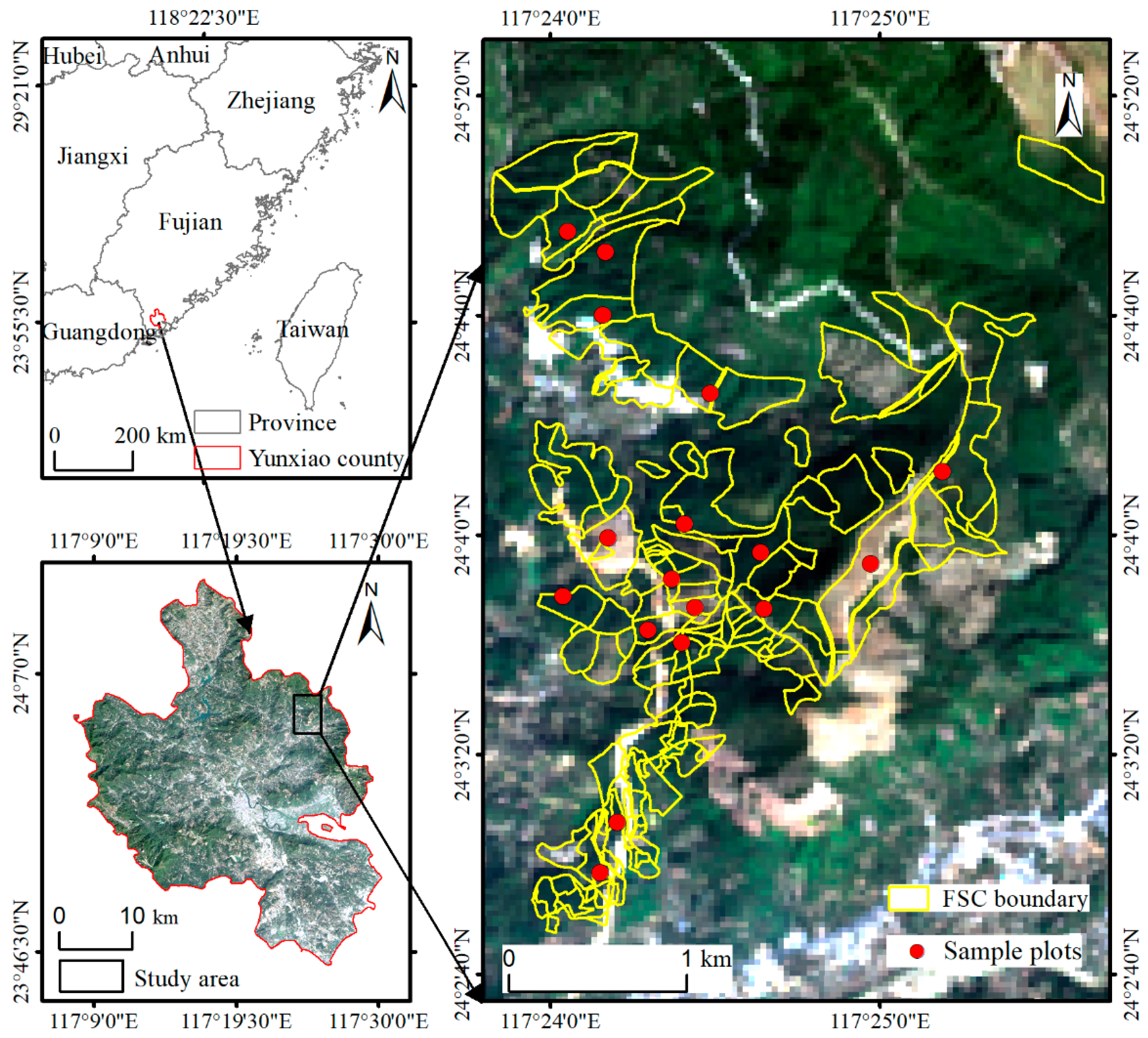
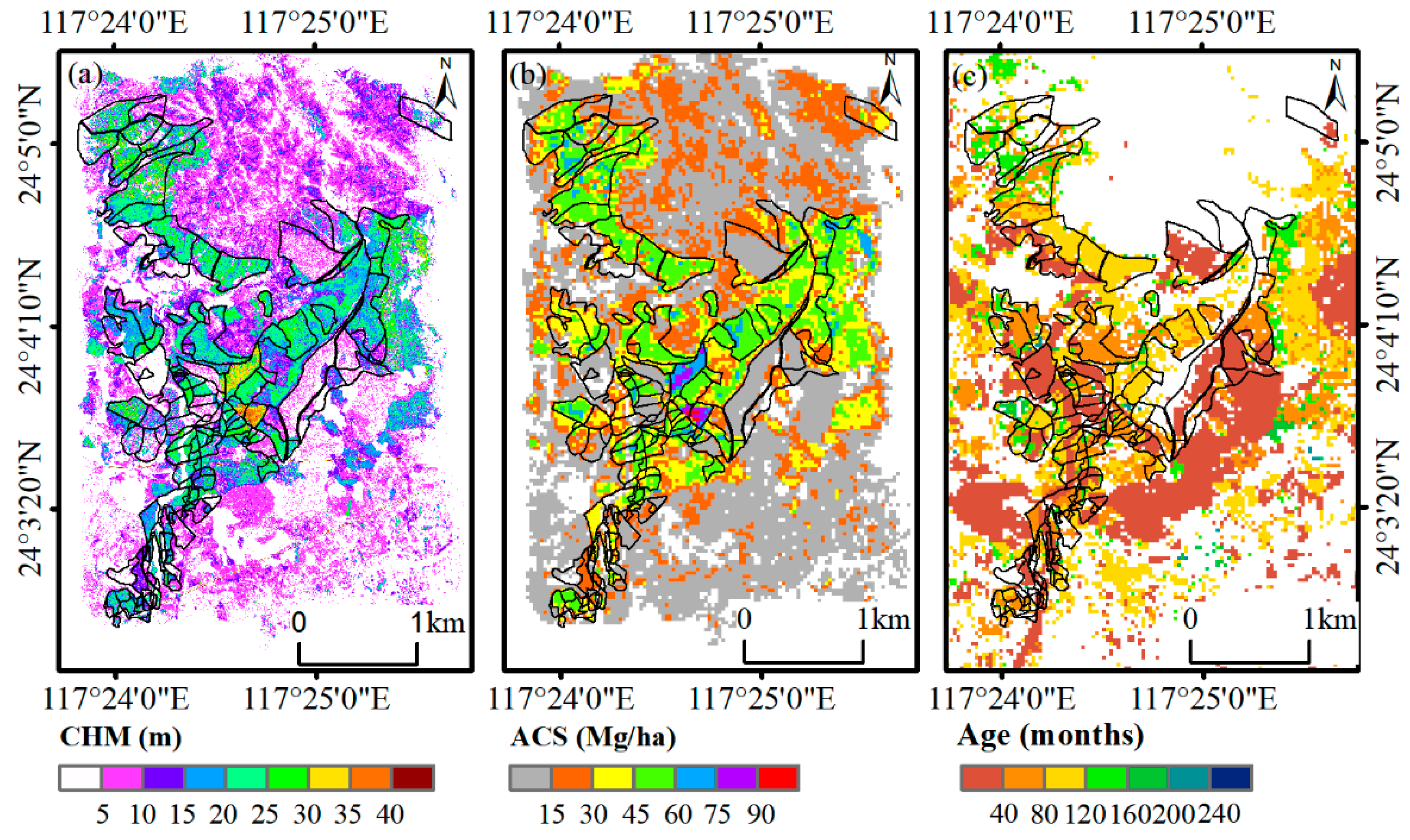
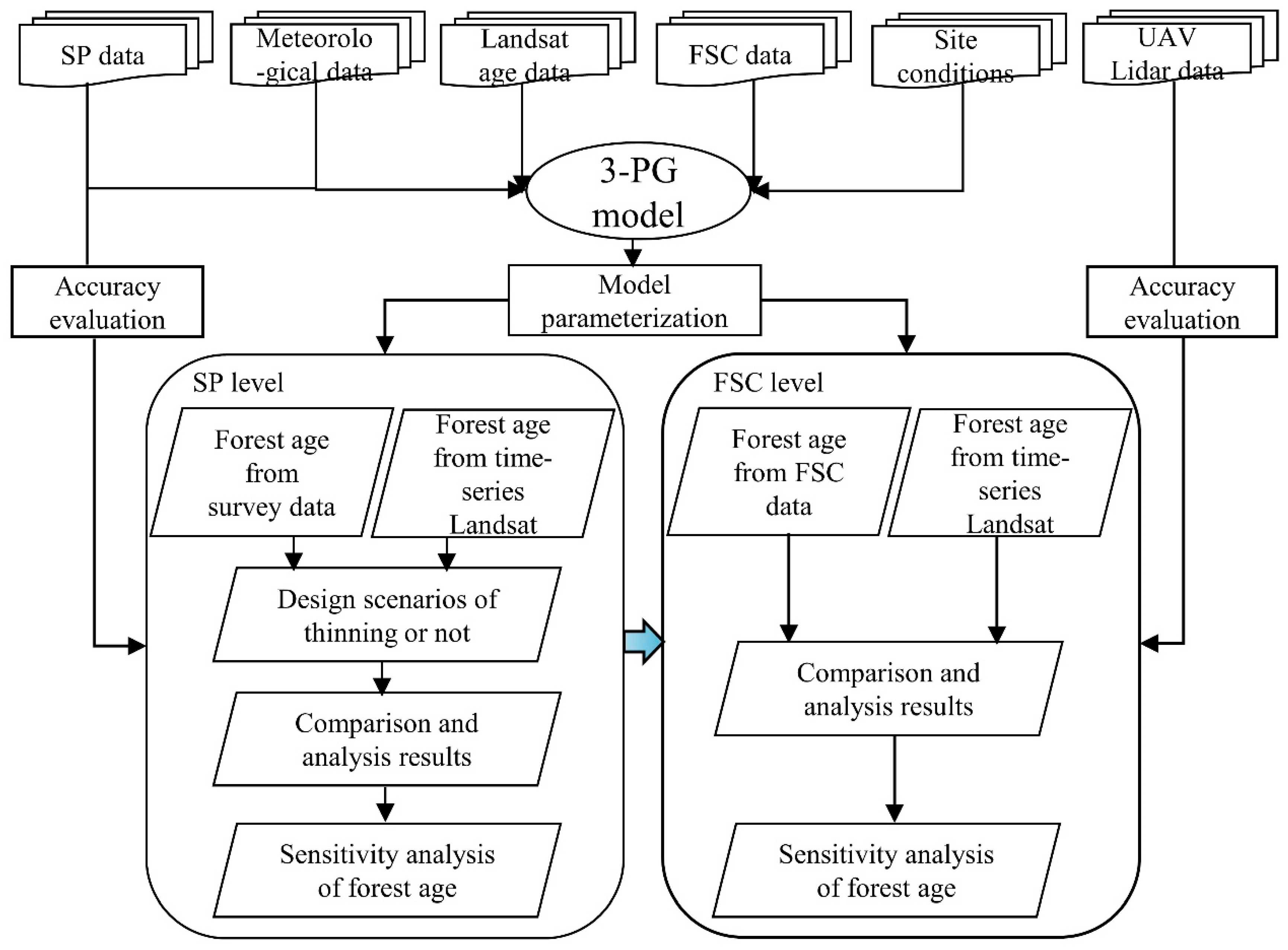

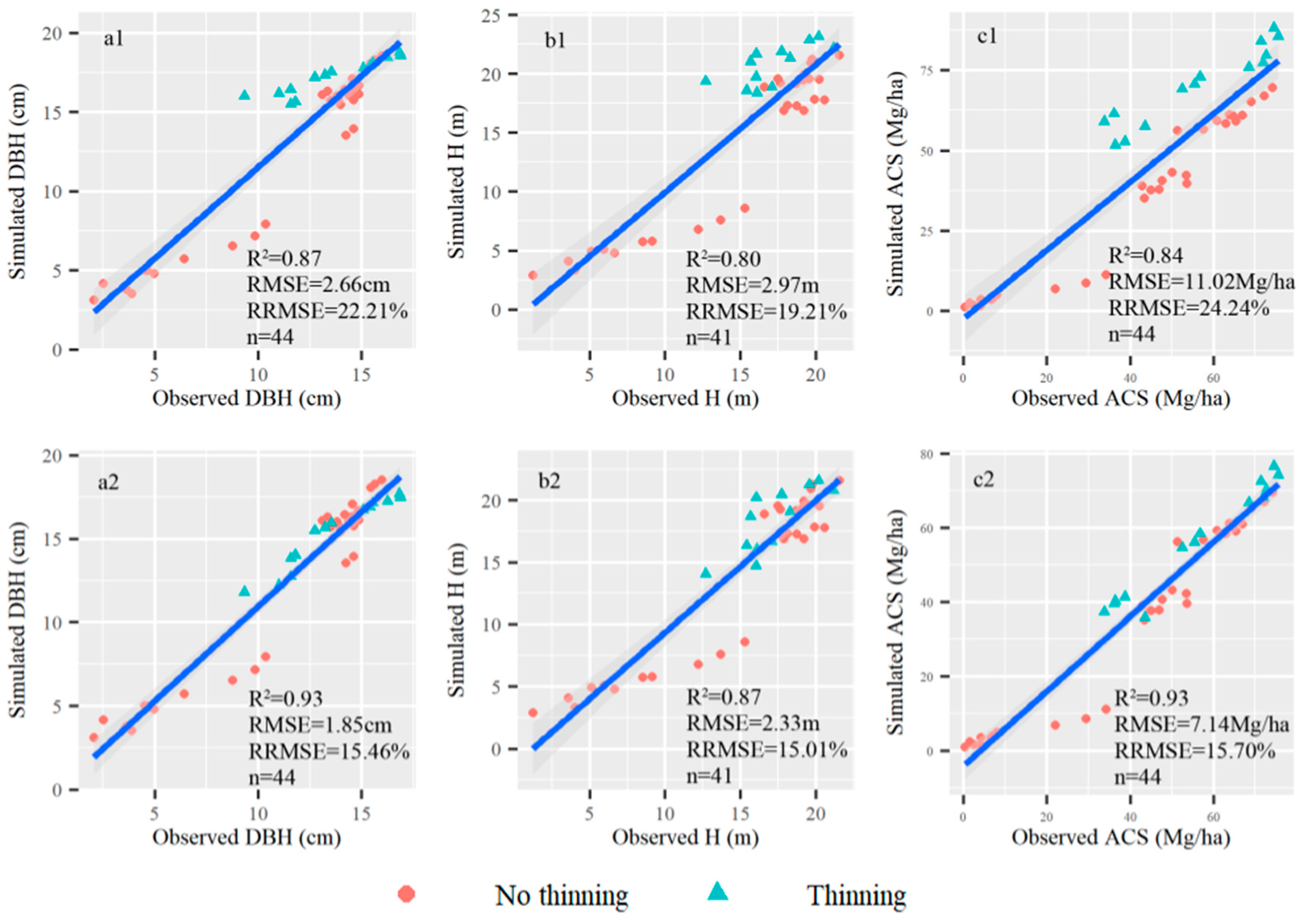


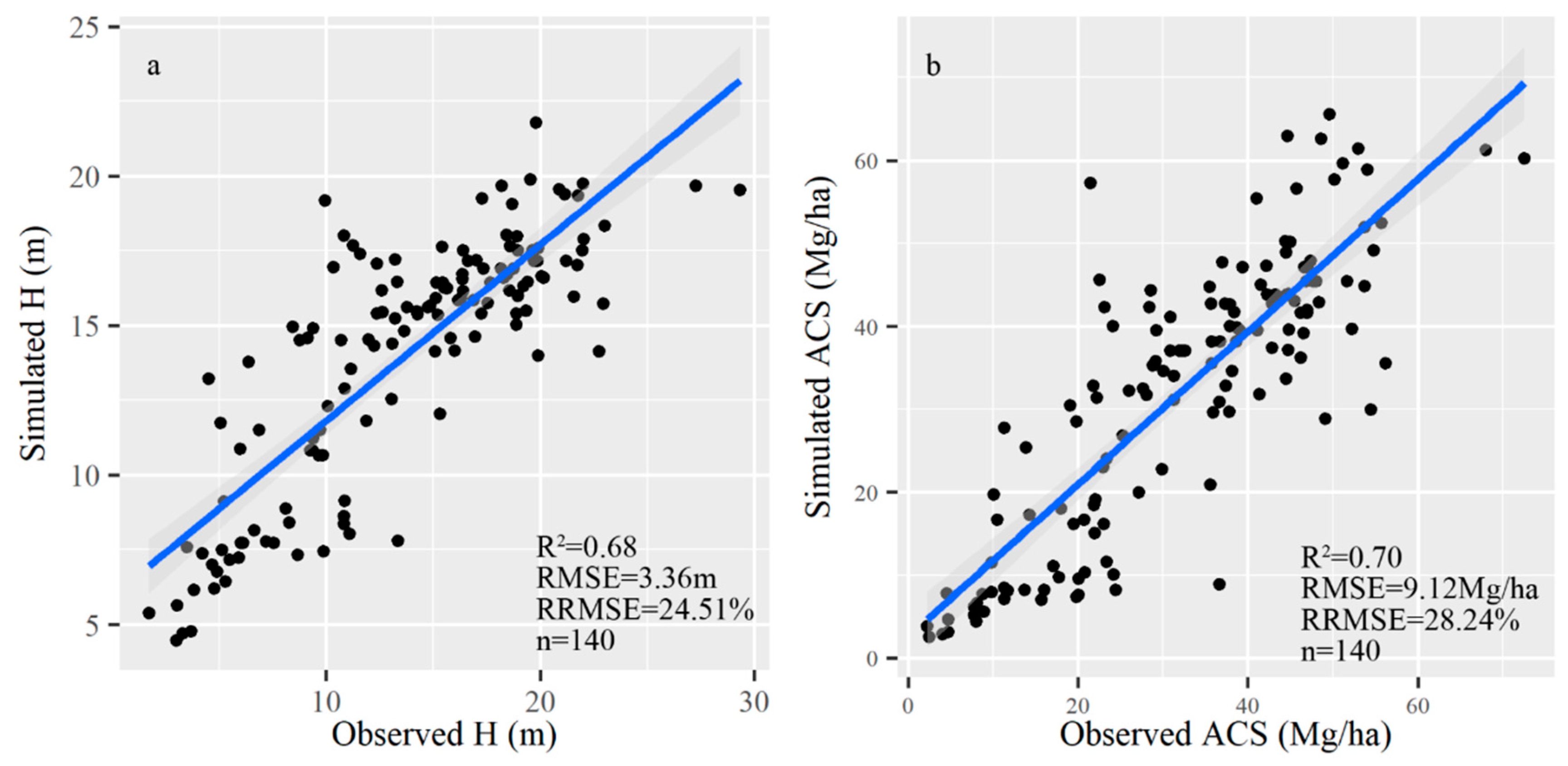
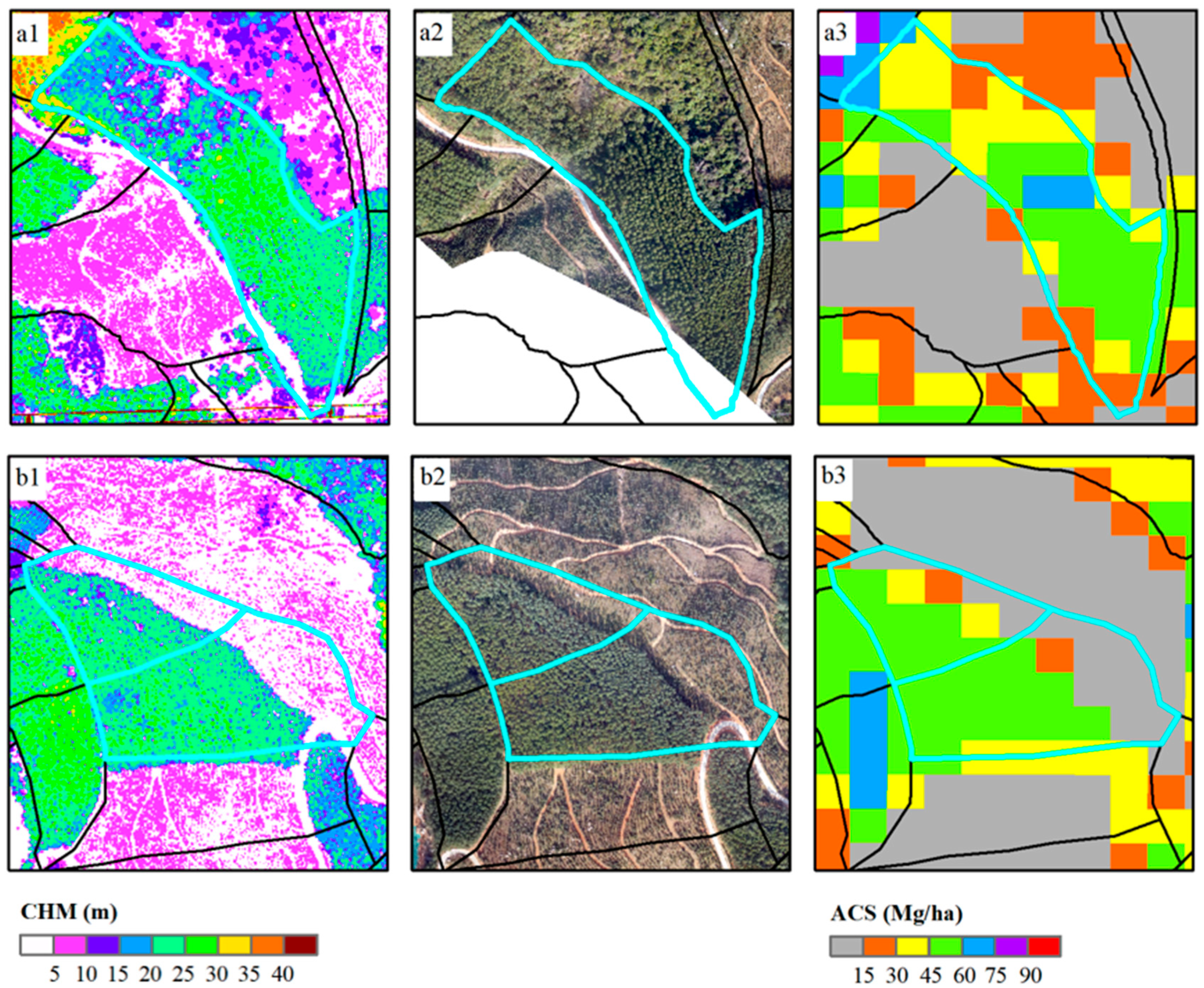
| Age (Year) | Number (n) | Mean DBH (cm) | Mean H (m) | Total Area (ha) |
|---|---|---|---|---|
| ≤4 | 55 | <9.5 | 2.5–10.8 | 105.38 |
| 5–8 | 26 | 10.9–17.6 | 12.3–22 | 115.75 |
| 9–12 | 53 | 11.5–24.4 | 14.3–29.2 | 143.25 |
| 13–17 | 6 | 20.8–24.6 | 21.7–28.3 | 14.82 |
| Total | 140 | 0–27.6 | 2.5–29.2 | 379.2 |
| Organ | Fitting Equation | R2 |
|---|---|---|
| Stem | W = 0.0259 × DBH2.8762 | 0.978 |
| Branch | W = 0.0263 × DBH2.2471 | 0.887 |
| Bark | W = 0.0539 × DBH1.7802 | 0.949 |
| Foliage | W = 0.1785 × DBH1.1753 | 0.871 |
| Variables | DBH | H | ACS | ||||||
|---|---|---|---|---|---|---|---|---|---|
| R2 | RMSE (cm) | Change Degree of RMSE | R2 | RMSE (m) | Change Degree of RMSE | R2 | RMSE (Mg/ha) | Change Degree of RMSE | |
| −3 months | 0.94 | 1.74 | 5.95% | 0.86 | 2.50 | 7.30% | 0.94 | 8.07 | 13.03% |
| −6 months | 0.93 | 1.68 | 9.19% | 0.85 | 2.77 | 18.88% | 0.93 | 9.56 | 33.89% |
| −12 months | 0.90 | 1.72 | 7.03% | 0.79 | 3.33 | 42.92% | 0.90 | 13.06 | 82.91% |
| No change | 0.93 | 1.85 | 0 | 0.87 | 2.33 | 0 | 0.93 | 7.14 | 0 |
| +3 months | 0.94 | 2.09 | 12.97% | 0.87 | 2.26 | 3% | 0.94 | 6.15 | 13.86% |
| +6 months | 0.94 | 2.29 | 23.78% | 0.87 | 2.25 | 3.43% | 0.95 | 5.92 | 17.09% |
| +12 months | 0.94 | 2.78 | 33.45% | 0.88 | 2.42 | 3.86% | 0.95 | 7.41 | 3.78% |
| Variables | H | ACS | ||||
|---|---|---|---|---|---|---|
| R2 | RMSE (m) | Change Degree of RMSE | R2 | RMSE (Mg/ha) | Change Degree of RMSE | |
| −3 months | 0.74 | 3.04 | −10.53% | 0.75 | 9.22 | 1.1% |
| −6 months | 0.73 | 3.04 | −10.53% | 0.74 | 9.27 | 1.64% |
| −12 months | 0.72 | 3.19 | 5.06% | 0.71 | 10.33 | 13.27% |
| No change | 0.68 | 3.36 | 0 | 0.70 | 9.12 | 0 |
| +3 months | 0.74 | 3.25 | −3.27% | 0.77 | 10.25 | 12.39% |
| +6 months | 0.74 | 3.4 | 1.19% | 0.77 | 11 | 20.61% |
| +12 months | 0.74 | 3.77 | 12.2% | 0.77 | 12.88 | 41.23% |
Disclaimer/Publisher’s Note: The statements, opinions and data contained in all publications are solely those of the individual author(s) and contributor(s) and not of MDPI and/or the editor(s). MDPI and/or the editor(s) disclaim responsibility for any injury to people or property resulting from any ideas, methods, instructions or products referred to in the content. |
© 2022 by the authors. Licensee MDPI, Basel, Switzerland. This article is an open access article distributed under the terms and conditions of the Creative Commons Attribution (CC BY) license (https://creativecommons.org/licenses/by/4.0/).
Share and Cite
Zhang, Y.; Lu, D.; Jiang, X.; Li, Y.; Li, D. Forest Structure Simulation of Eucalyptus Plantation Using Remote-Sensing-Based Forest Age Data and 3-PG Model. Remote Sens. 2023, 15, 183. https://doi.org/10.3390/rs15010183
Zhang Y, Lu D, Jiang X, Li Y, Li D. Forest Structure Simulation of Eucalyptus Plantation Using Remote-Sensing-Based Forest Age Data and 3-PG Model. Remote Sensing. 2023; 15(1):183. https://doi.org/10.3390/rs15010183
Chicago/Turabian StyleZhang, Yi, Dengsheng Lu, Xiandie Jiang, Yunhe Li, and Dengqiu Li. 2023. "Forest Structure Simulation of Eucalyptus Plantation Using Remote-Sensing-Based Forest Age Data and 3-PG Model" Remote Sensing 15, no. 1: 183. https://doi.org/10.3390/rs15010183
APA StyleZhang, Y., Lu, D., Jiang, X., Li, Y., & Li, D. (2023). Forest Structure Simulation of Eucalyptus Plantation Using Remote-Sensing-Based Forest Age Data and 3-PG Model. Remote Sensing, 15(1), 183. https://doi.org/10.3390/rs15010183







